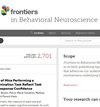探索各种认知环境下学习与工作记忆之间的动态相互作用
IF 2.6
3区 医学
Q2 BEHAVIORAL SCIENCES
引用次数: 0
摘要
引言 大脑中强化学习和工作记忆之间相互交织的关系是一个复杂的课题,在神经科学的各个领域都有广泛的研究。研究工作主要集中在确定负责这些功能的特定脑区,了解它们在完成相关任务中的贡献,以及探索它们在认知障碍或衰老等条件下的适应性。方法目前已经引入了大量模型来分别阐述强化学习和工作记忆这两个子系统,或它们在执行认知任务中的组合和关系。本研究采用 RLWM 模型作为计算框架,分析因年龄或认知状况而认知能力不同的受试者的行为参数。结果分析表明,随着年龄的不同(青年与中年),受试者的整体表现准确性和速度都有所下降。在学习率、WM 衰减和决策噪声等模型参数方面也发现了显著差异。此外,在中年组中,根据MoCA评分被归类为正常与MCI的受试者在速度、表现准确性和决策噪音方面出现了明显的差异。本文章由计算机程序翻译,如有差异,请以英文原文为准。
Exploring the dynamic interplay between learning and working memory within various cognitive contexts
IntroductionThe intertwined relationship between reinforcement learning and working memory in the brain is a complex subject, widely studied across various domains in neuroscience. Research efforts have focused on identifying the specific brain areas responsible for these functions, understanding their contributions in accomplishing the related tasks, and exploring their adaptability under conditions such as cognitive impairment or aging.MethodsNumerous models have been introduced to formulate either these two subsystems of reinforcement learning and working memory separately or their combination and relationship in executing cognitive tasks. This study adopts the RLWM model as a computational framework to analyze the behavioral parameters of subjects with varying cognitive abilities due to age or cognitive status. A related RLWM task is employed to assess a group of subjects across different age groups and cognitive abilities, as measured by the Montreal Cognitive Assessment tool (MoCA).ResultsAnalysis reveals a decline in overall performance accuracy and speed with differing age groups (young vs. middle-aged). Significant differences are observed in model parameters such as learning rate, WM decay, and decision noise. Furthermore, among the middle-aged group, distinctions emerge between subjects categorized as normal vs. MCI based on MoCA scores, notably in speed, performance accuracy, and decision noise.
求助全文
通过发布文献求助,成功后即可免费获取论文全文。
去求助
来源期刊

Frontiers in Behavioral Neuroscience
BEHAVIORAL SCIENCES-NEUROSCIENCES
CiteScore
4.70
自引率
3.30%
发文量
506
审稿时长
6-12 weeks
期刊介绍:
Frontiers in Behavioral Neuroscience is a leading journal in its field, publishing rigorously peer-reviewed research that advances our understanding of the neural mechanisms underlying behavior. Field Chief Editor Nuno Sousa at the Instituto de Pesquisa em Ciências da Vida e da Saúde (ICVS) is supported by an outstanding Editorial Board of international experts. This multidisciplinary open-access journal is at the forefront of disseminating and communicating scientific knowledge and impactful discoveries to researchers, academics, clinicians and the public worldwide.
This journal publishes major insights into the neural mechanisms of animal and human behavior, and welcomes articles studying the interplay between behavior and its neurobiological basis at all levels: from molecular biology and genetics, to morphological, biochemical, neurochemical, electrophysiological, neuroendocrine, pharmacological, and neuroimaging studies.
 求助内容:
求助内容: 应助结果提醒方式:
应助结果提醒方式:


